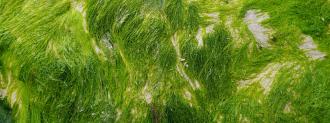Another effort to sequester atmospheric carbon with ocean-going kelp forests has been launched. The startup, Phykos, has sent a prototype of a solar-powered watercraft on a carbon-sequestering cruise in the Pacific Ocean, dragging along a submerged rack of seaweed.
The goal is that fleets of these robots will suck up tons of carbon dioxide and then deep-six it to the bottom of the ocean, where it will be stored forever.
Sinking an offshore forest: At Phykos, the team wants to tap into the natural carbon sequestration process by growing kelp forests in the open ocean and, less naturally, sinking them to the seafloor to bury their carbon.
Kelp may be a jackpot for carbon sequestration.
“Seaweeds have evolved to grow crazy fast and are fantastic at drawing out CO2,” cofounder Nico Julian told Fast Company. “Essentially what we’re just doing is giving them a bigger surface area, out in the open ocean, to do their same magic.”
Lines are seeded in a nursery with kelp, then set out to navigate the ocean in autonomous boats. While cruising the sea, the kelp forest continues to grow bigger, soaking up carbon. When it is big enough, it will “harvest” itself, sinking to the bottom of the ocean, trapping carbon for an estimated 1,000 years.
“The seaweeds will grow and periodically get a haircut, so to speak, with an integrated harvest clipper mechanism,” Julian said.
The company is still in the early stages and just completed a summer with the startup incubator Y Combinator. They are still researching how the boats will impact wildlife and measuring how much carbon the kelp forests could sequester.
The promise of kelp: Kelp may be a jackpot for carbon sequestration.
According to a 2016 study, seaweed may naturally store roughly 175 million tons of carbon per year globally. And, if the seaweed sinks to the bottom of the ocean, it can be sequestered for centuries.
“Seaweeds have evolved to grow crazy fast and are fantastic at drawing out CO2.”
Nico Julian
With all that promise, one would think startups, ready to capitalize on the growing carbon market, would be rushing to grow more kelp forests. But there is a challenge: seaweed naturally grows near the coast, in water shallow enough that the sunlight penetrates. But if the kelp dies in shallow water, it would soon decay and release CO2 back into the sea and air. It needs to be sunk to great depths to be sequestered for centuries.
So, startups are looking for creative ways to create offshore surface kelp forests. The ideas vary but all reflect a similar goal to Phykos: find an innovative way to grow seaweed at the surface but then sink it to great depths. Some solutions include floating mini kelp farms on biodegradable buoys set adrift in ocean currents or growing giant bladder-kelp on semi-autonomous vessels in offshore waters.
We’d love to hear from you! If you have a comment about this article or if you have a tip for a future Freethink story, please email us at [email protected].






